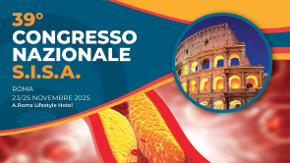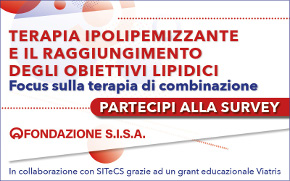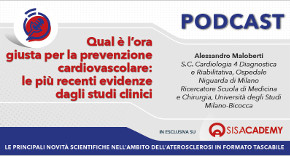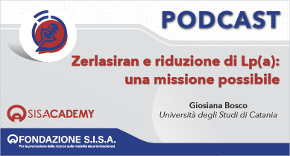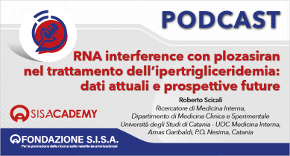 Rivista in lingua italiana
Rivista in lingua italiana
riservata ai Soci SISA
Ultimo numero:
Anno 16 • N.1/2025
Abstract
Subclinical hyperthyroidism and the risk of coronary heart disease and mortality
Collet TH, Gussekloo J, Bauer DC, den Elzen WP, Cappola AR, Balmer P, Iervasi G, Åsvold BO, Sgarbi JA, Völzke H, Gencer B, Maciel RM, Molinaro S, Bremner A, Luben RN, Maisonneuve P, Cornuz J, Newman AB, Khaw KT, Westendorp RG, Franklyn JA, Vittinghoff E, Walsh JP, Rodondi N.Arch Intern Med 2012;172:799-809
BACKGROUND: Data from prospective cohort studies regarding the association between subclinical hyperthyroidism and cardiovascular outcomes are conflicting.We aimed to assess the risks of total and coronary heart disease (CHD) mortality, CHD events, and atrial fibrillation (AF) associated with endogenous subclinical hyperthyroidism among all available large prospective cohorts.
METHODS: Individual data on 52 674 participants were pooled from 10 cohorts. Coronary heart disease events were analyzed in 22 437 participants from 6 cohorts with available data, and incident AF was analyzed in 8711 participants from 5 cohorts. Euthyroidism was defined as thyrotropin level between 0.45 and 4.49 mIU/L and endogenous subclinical hyperthyroidism as thyrotropin level lower than 0.45 mIU/L with normal free thyroxine levels, after excluding those receiving thyroid-altering medications.
RESULTS: Of 52 674 participants, 2188 (4.2%) had subclinical hyperthyroidism. During follow-up, 8527 participants died (including 1896 from CHD), 3653 of 22 437 had CHD events, and 785 of 8711 developed AF. In age- and sex-adjusted analyses, subclinical hyperthyroidism was associated with increased total mortality (hazard ratio[HR], 1.24, 95% CI, 1.06-1.46), CHD mortality (HR,1.29; 95% CI, 1.02-1.62), CHD events (HR, 1.21; 95%CI, 0.99-1.46), and AF (HR, 1.68; 95% CI, 1.16-2.43).Risks did not differ significantly by age, sex, or preexisting cardiovascular disease and were similar after further adjustment for cardiovascular risk factors, with attributable risk of 14.5% for total mortality to 41.5% forAF in those with subclinical hyperthyroidism. Risks for CHD mortality and AF (but not other outcomes) were higher for thyrotropin level lower than 0.10 mIU/L compared with thyrotropin level between 0.10 and 0.44 mIU/L(for both, P value for trend, .03).
CONCLUSION: Endogenous subclinical hyperthyroidism is associated with increased risks of total, CHD mortality, and incident AF, with highest risks of CHD mortality and AF when thyrotropin level is lower than 0.10 mIU/L.
Arch Intern Med 2012;172:799-809

Area Soci
Eventi
39° Congresso Nazionale
 39° Congresso Nazionale
39° Congresso NazionaleRoma, 23-25 novembre 2025
Save the date




 Spring Meeting Gruppi Giovani SID, SIGG, SIIA, SIMI, SIPREC, SISA
Spring Meeting Gruppi Giovani SID, SIGG, SIIA, SIMI, SIPREC, SISARimini, 6-8 aprile 2025
[continua a leggere]
 SISA LIPID ACADEMY - Corso avanzato di lipidologia clinica
SISA LIPID ACADEMY - Corso avanzato di lipidologia clinicaModena, 4-5 Luglio 2024
[continua a leggere]Giornale Italiano Arteriosclerosi
HoFH today
 Rivista Italiana della
Rivista Italiana della
Ipercolesterolemia
Familiare Omozigote
Anno 6 • N.1/2024
Rivista NMCD
Diateca
[continua a leggere]
[continua a leggere]
Newsletter
il vostro indirizzo di posta elettronica
Progetto LIPIGEN

Nuovo sito dedicato al Progetto LIPIGEN
Progetto LIPIGEN - Vecchio portale
E' necessario essere loggati come utente
Lipigen per poter accedere alla pagina
PROject Statin Intolerance SISA
PROSISA – PROject Statin Intolerance SISA
E' necessario essere loggati come utente
PROSISA per poter accedere alla pagina
GILA - Lipoprotein Aferesi
Gruppo Interdisciplinare Lipoprotein Aferesi
(Accesso Gruppo GILA-Lipoprotein Aferesi)
E' necessario essere loggati come utente del Gruppo GILA per poter accedere
Gruppo Interdisciplinare Lipoprotein Aferesi
(Documentazione ad accesso libero)
Pagina informativa per medici e pazienti


